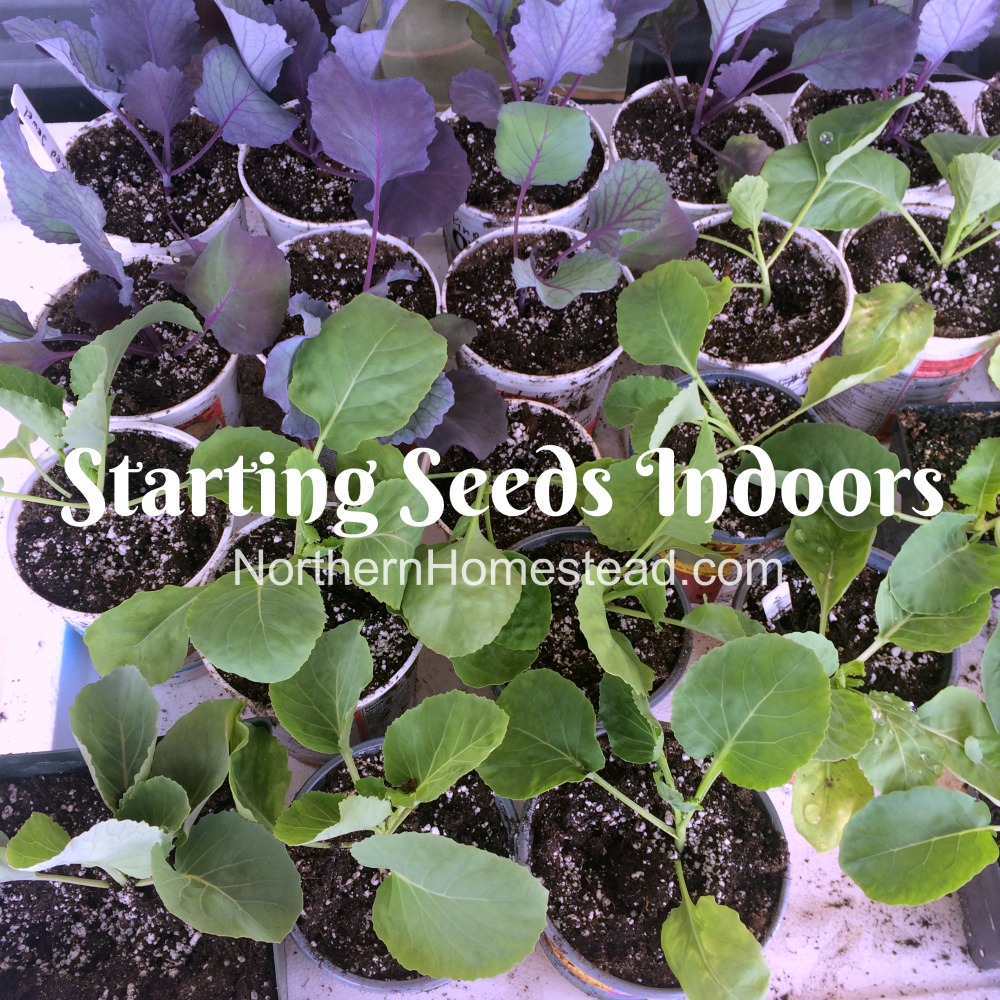
Winter in our area isn’t over yet. The last frost date is still a few months away. But spring is coming, and with it the next growing season! Starting vegetable seeds indoors is the start of it.
When we say starting seeds indoors, we don’t mean in the house (even though it can be that), but in an enclosed environment that is best for the particular seed we are starting.
Why start seeds indoors?
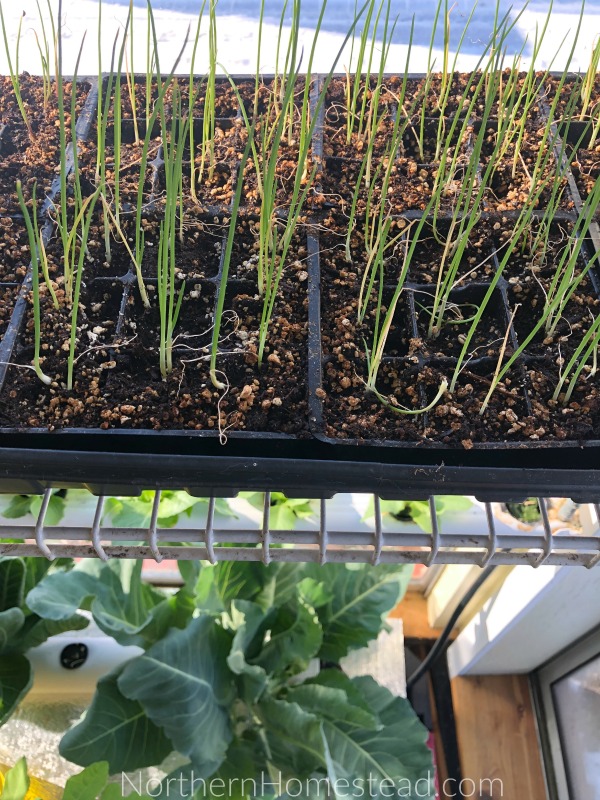
We mainly start seeds indoors, or in an enclosed environment, because of our short growing season. This way we can extend the season upfront. While it is still snowing outside, we grow young plants inside to transplant into the garden as soon as the weather conditions are right for the particular plant.
Growing plants from seeds is a lot of fun. I am always amazed at how a new plant grows out of a dry little something (seed) and produces delicious fruits that contain the same seed to produce new plants.
Starting plants from seed also saves money. It isn’t a lot of work, but you can start many seedlings yourself for the price of buying one plant.
The best growing conditions for starting seeds
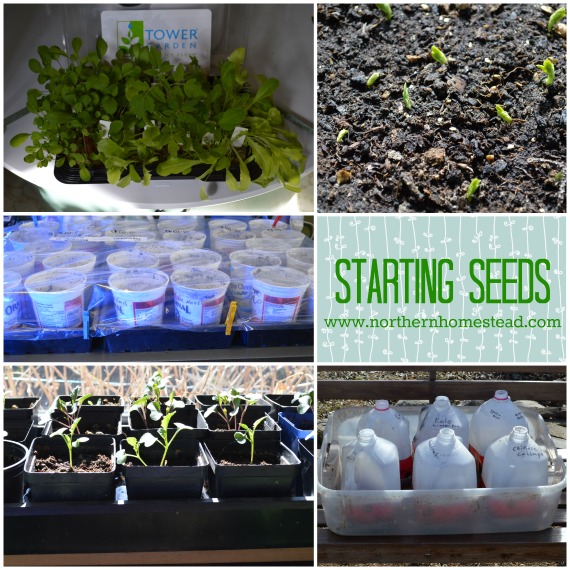
We said in the spring starting seed schedule article, that you have two options when it comes to starting seeds indoors, add more time, meaning starting seeds very early, or you can create better-growing conditions, so the seeds germinate and grow fast. We aim for the latter. For any given plant variety we want to create optimal growing conditions.
Not all seeds are best started in a warm place; depending on the climate, a propagating greenhouse or even a cold frame might be a better option since it also has more optimal light. The idea is to have a place that is sheltered and somewhat warmer than the outside to get a head start on seedlings.
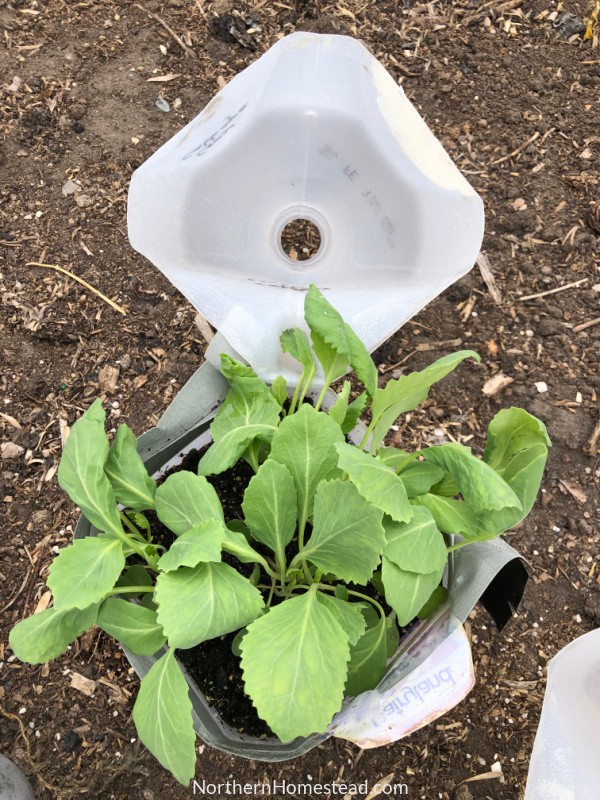
In our cold climate (Zone 3), seeds can be started in all of the above and even outdoors by using winter sowing (follow the link to read more about that). Winter sowing works great for cool-weather plants like cabbage, lettuce, and other greens. If you only have limited space indoors, move all the cool-weather crops outside. In our seed-starting schedule, those are all the plants that can be planted out before the last frost date.
A warm and sunny location is best for heat-loving summer crops like peppers and tomatoes. We will discuss supplemental light more below.
When to start seeds indoors?
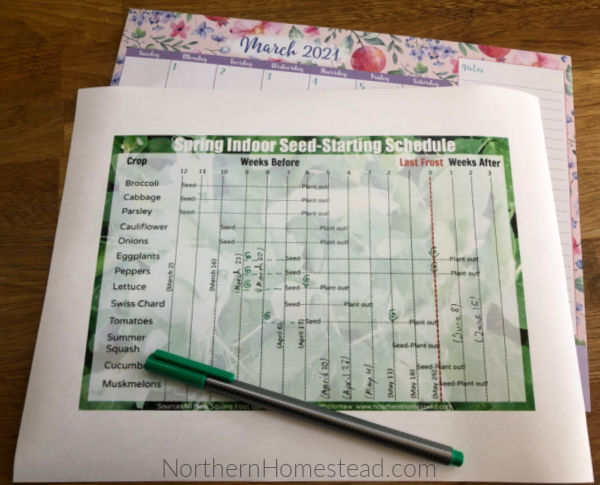
In this blog post, we thoroughly cover the timing of planting seeds. Here, we want to emphasize that we do not recommend starting seeds too early. There is no need to pamper seedlings for months; they grow much faster later in the season when they benefit from natural sunlight and warmth. Additionally, there are great alternatives to growing seedlings if waiting for spring is hard.
What do you need to start seeds indoors?
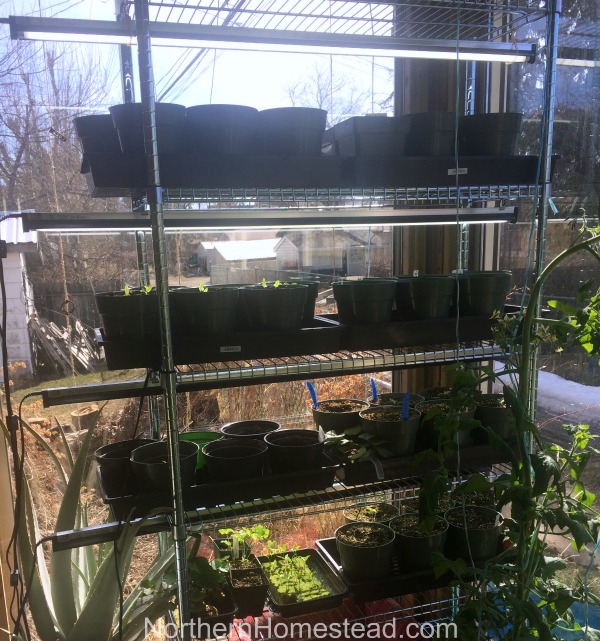
– Pots
Seed-starting pots or propagation trays come in all shapes and sizes. If you want to avoid plastic, you can build your own pots out of newspapers or avoid pots altogether by using a soil block maker. There are also peat moss pots available, but from our experience, they don’t work so well—maybe because our climate is too dry.
The size of the container depends on how long the plants will be growing in that pot. We like to avoid potting plants up when space is limited; that is an option.
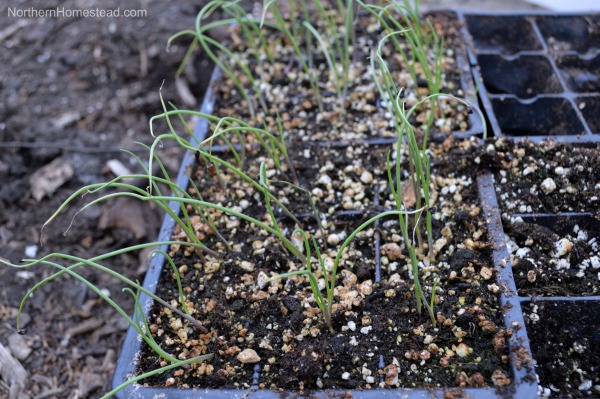
We use small planters (often recycled from plants we have bought here and there) for plants that are not staying inside long: like cabbage, onions, or lettuce.
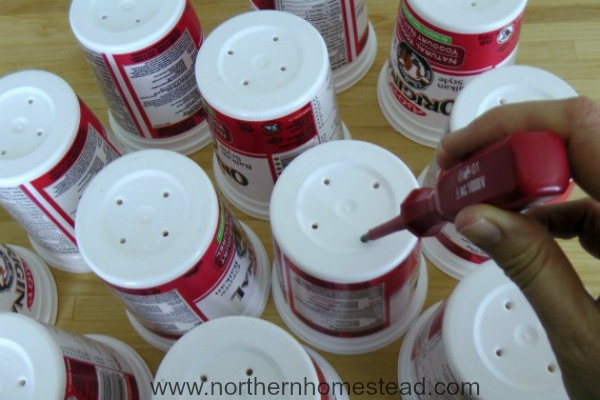
Also, we mostly use the (free) yogurt containers for peppers and tomatoes. They seem to be the optimal size for those plants and save me some replanting work.
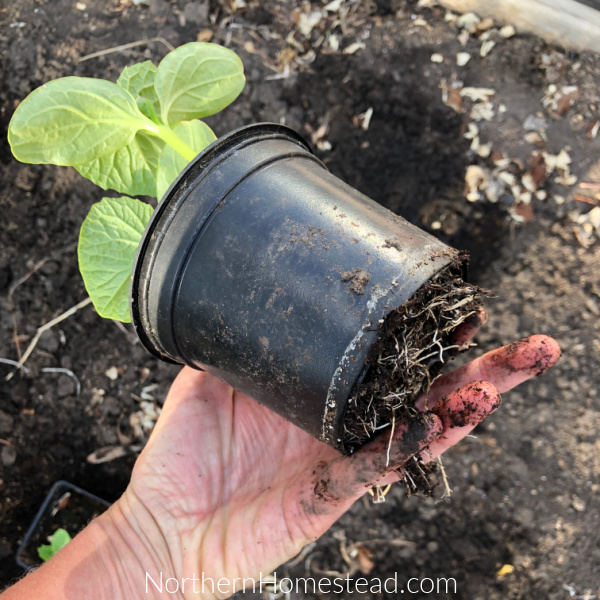
Recycled toilet paper tubes make great cucumber planters. They can be planted with the seedling into the ground without disturbing the roots. A bottomless pot is another excellent option for cucumber family plants.
For squash and bigger plants, we use a bigger container so that the roots have more room to grow and are not disturbed by transplanting. Or again, try the bottomless pot method.
Propagation seed starter trays are great if you want to start on plants like lettuce, chard, beets, etc.
As in most cases with gardening, we encourage you to keep things simple and achievable. Plants will grow in whatever pots you start them in. You can be specific, but there is no real need.
We recommend sturdy planter trays. They make it easier to handle many seedlings at once.
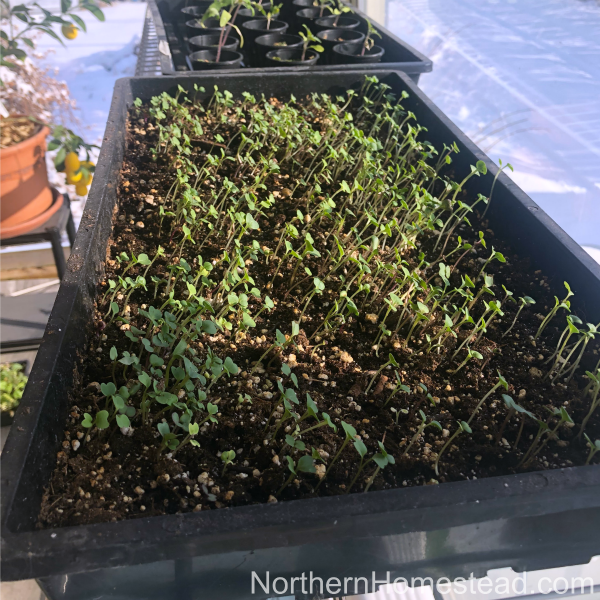
You can grow microgreens in them in winter, so it’s sure worth it to have them.
– Soil to start seeds
The soil is important. You want good, light soil. A special seed starting mix or sterilized soil that is very fine might be important for some very small seeds. However, it is not needed for most vegetables.
Make your own soil, Mel’s Mix from the Square Foot Garden book. Mix together: 1/3 compost or warmcasting, 1/3 vermiculite, and 1/3 peat moss.
These ingredients can be found in a garden center or Home Depot. This is our favorite soil to use; it is not as high in peat moss as ProMix, and much higher in natural compost. It has been harder to find natural, bug-free compost lately. Read more about the DIY container soil here.
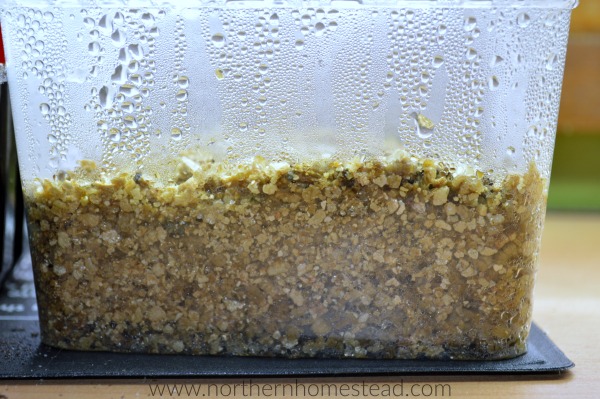
You can use vermiculite instead of soil to sow seeds in seed trays and prick them out later. We have a whole blog post about it; to learn more, go here.
– Seeds
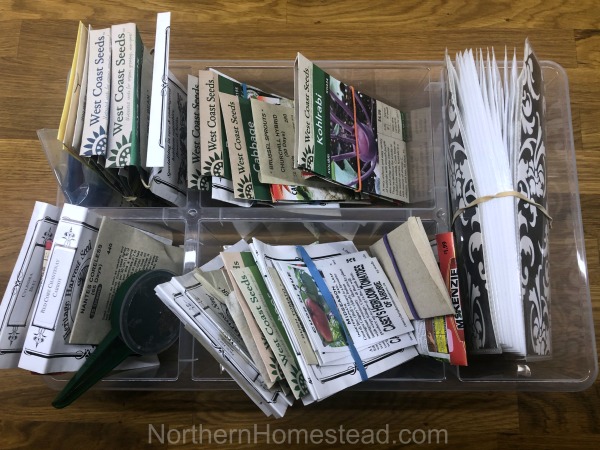
We have lots of information on getting seeds for the new growing season. As well as plant varieties we grow in our short growing season. Please follow the links to read more.
– Labels
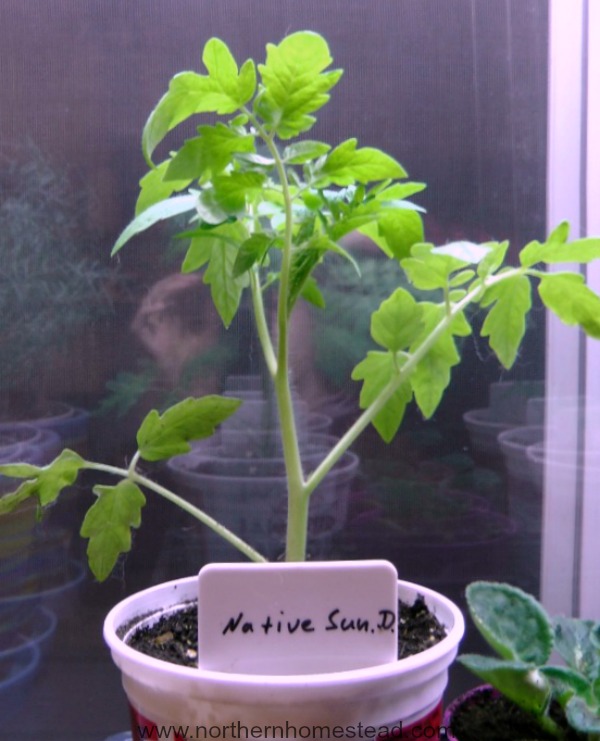
Labeling is important so you know what varieties you are growing. It does not matter what kind of labels you use. Garden labels are great, but a plastic spoon works just as well. To avoid plastic, you can use wooden labels, unless you make your own, you will spend more money though since they don’t last as long as the plastic labels do.
Also, a garden notebook is a helpful gardening tool. Here is how to make your own.
– Heat Mat
As we already mentioned, many seeds need warm temperatures to germinate, so find a warm spot in your house. The top of a fridge would be a better place than a cold but bright window. Placing the tray on top of a heating vent in the winter is great, too. You want about 85°F, 29°C for fast germination. A Germination Station with a Heat Mat can be helpful.
After germinating, not all seedlings like it warm. Winter crops, like the cabbage family plants, like it rather cool. We find they do better in a sunny basement window or out in the garage greenhouse. You can also use winter sowing for cold-weather crops.
– Grow lights
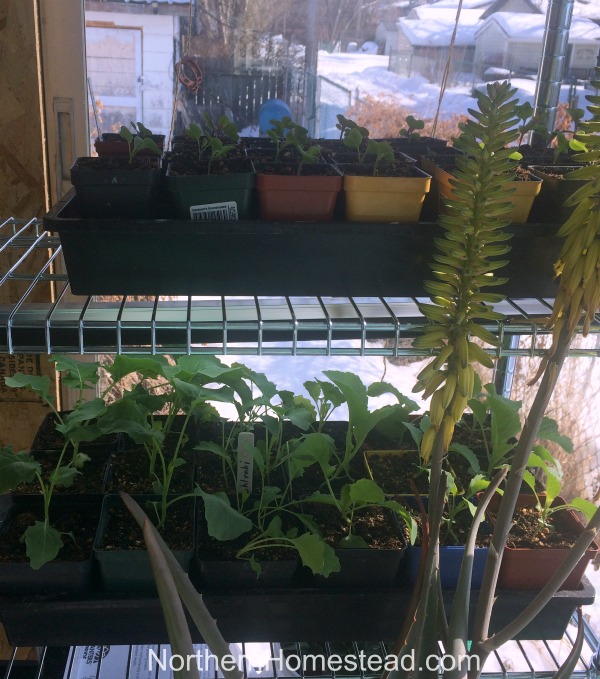
A seed needs moisture and nice warm temperatures for germination, but not so much light. As soon as the seeds are up, young plants need a lot of light.
Starting seeds later in the season (see the planting schedule), helps with better light conditions, so that you might not require any grow lights. A south-facing window might be all you need. Read more about starting seeds without grow lights here.
Whenever possible, we recommend using a sunny window since a grow light is more comparable to a cloudy day than direct sunlight. To imitate sunlight, you will need expensive grow lights, which can make growing seedlings costly.
But if your spring is mostly cool and overcast, or you do not have good south-facing windows, adding grow light might be essential. An east- or west-facing window can be used with supplemental light. T5 lights work well as supplementary lights; LED lights are more energy efficient. A north window is not a good choice for seedlings.
How to sow seeds indoors
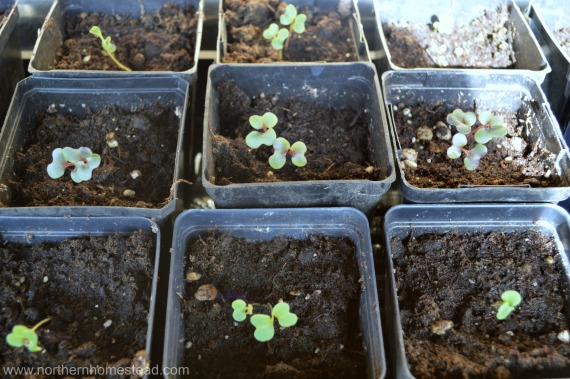
Fill a container with soil and compact it down slightly. You want your container to be filled without air pockets, but also not too compacted. If the soil is dry, now is a good time to water. Make sure the soil is moist before planting the seeds.
We usually do not sow seeds in seed trays to prick them out later, it’s just one more step of work, and why do more if you don’t have to? But it is an option too.
Plant seeds no more than 3 times their size deep. Since we are indoors, they can be planted even more shallowly. Only peas and beans do better if well covered. But we usually don’t start them indoors anyway.
Plant 1-3 seeds for plants that grow best alone, like lettuce, tomatoes, and cabbage. Once the seedlings are up and growing, thin them out to have just one plant. See also what to do with multiple plants in one seedling for more options.
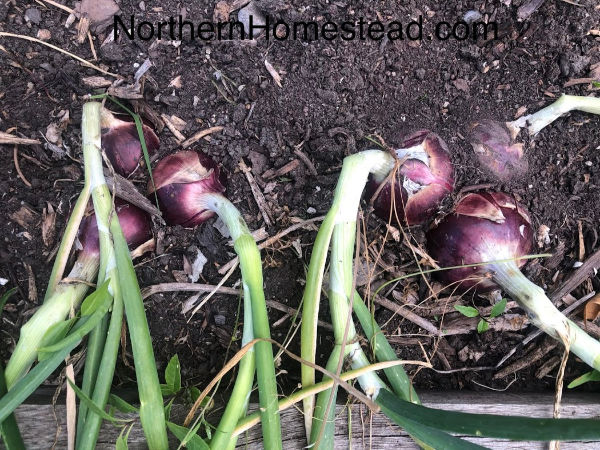
Onions, beets, and radishes love growing together as a cluster; you can start 4-6 seeds in one pot.
After the seeds are planted, water them in. Small seeds are best sprayed; for larger seeds, a small watering can can be used. In our dry climate, we also like to cover the pots with plastic wrap to keep moisture.
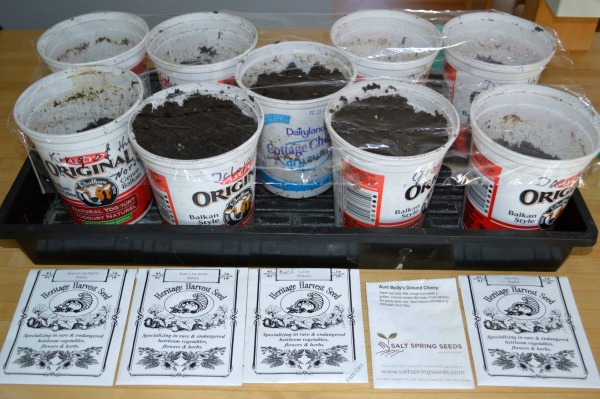
We have a separate post for starting tomatoes from seeds, to save ourselves even more transplanting work.
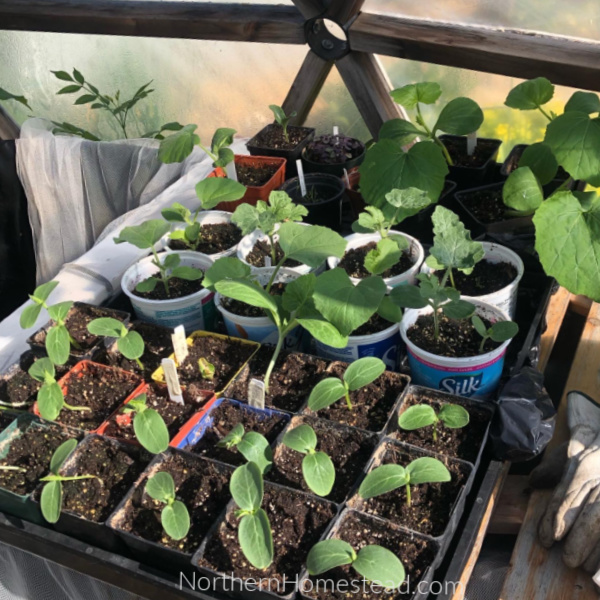
Read more about hardening off seedlings the easy way, and how to transplant seedlings into the ground.
Do you prefer starting your plants from seeds or buying seedlings? Please share your thoughts in the comments below.
We invite you to subscribe to Northern Homestead and follow us on Instagram, Facebook, or Pinterest for the latest updates.


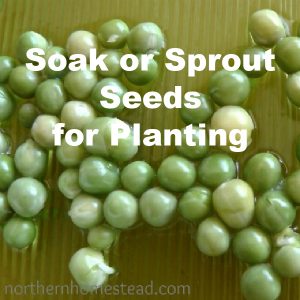
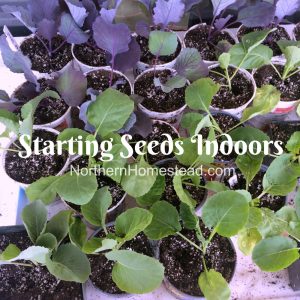
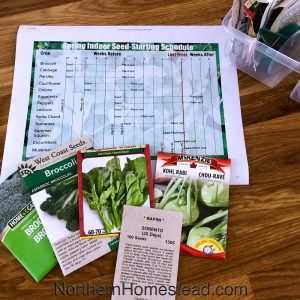
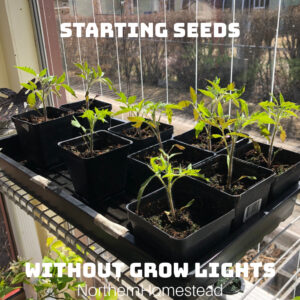
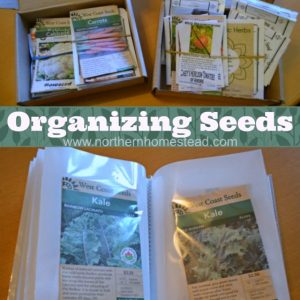
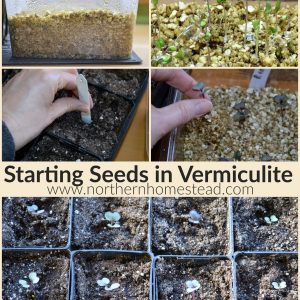
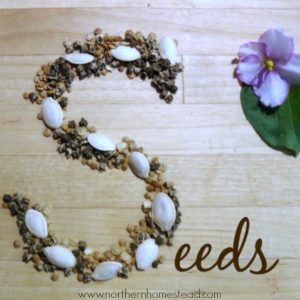
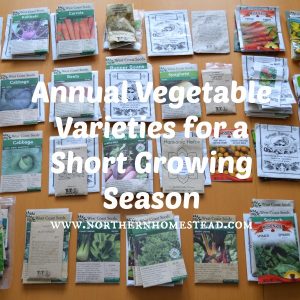
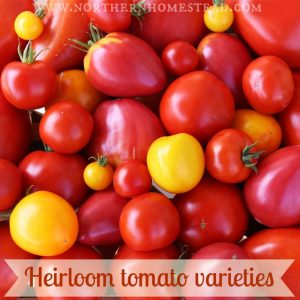

I really want to start some seeds inside. I love to watch things grow. And you make it look so easy.
Well, it is easy ;). The main thing is – Just do it. I need to start some more too. So lets go to work!
I’ll have to figure out a window I can keep the dog and cat away from LOL Last week Taffy jumped at something she saw outside and ran smack into the window. That would have really messed up any plants I had there LOL
Keeping plants from pets is not easy. Good luck with it!
I use a book case which inconvientally runs up the side of my fridge and into pantry, have all my trays and pots in little batches (meat Trays are good) ready for replanting when weather warms a little and Mother Mud Guts and her Boy (2 big dogs) are always wanting window space, so nothing was sacred till I started the book case, if they knock it, they hurt, they learn to dodge it, as we have to.
This is good information. I’m really enjoying your site. I will be spending more time on it.
Thanks for Sharing at Green Thumb Thursday.
Hugs,
Valerie
Glad you enjoying it! Thank you for hosting!
I always start seeds indoors, but usually end up buying some seedlings too. I live by the cutest nursery and never can resist the rows and rows of plants!
~Lisa
I hear you, going to nursery’s is so fun, plus some plants just don’t start so well at home (maybe it’s just an excuse to buy them ;)).
I hear you loud and clear on not being patient enough to wait. I usually start some seeds too soon, but that gets it out of my system. I started hundreds of hot peppers last month, leeks, edible flowers and am starting tomatoes tomorrow and the brassica family out in the unheated greenhouse tomorrow. It’s always reassuring to read other people’s posts to keep inspired and know we’re all on the right track. I’m frustrated by our -17C temp prediction for tonight – grrrr.
-17C is to cold for my liking. But what can we do, right? WE just go with the weather. My cabbage is up and growing in the greenhouse, tomatoes have to wait. I now have the Tower Garden, that helps a lot, since I can grow year round.
I started some seeds yesterday! Onions, leeks, peppers. These all seem to take a long time to germinate in my house (wood stove – different heat zones) so I start them first. I’ve got 17 different kinds of peppers! I guess I got a little pepper happy when ordering seeds (in my defense, my daughter bought some of them, and they keep a few years so I’ve got a bit of a stash). The next thing I’ll start is parsley, celery, some annuals, sage, cabbage, cauliflower, brussels sprouts, broccoli, tomatoes, more flowers . . . more veggies, more herbs . . . my kitchen will soon be a mini-greenhouse.
That sounds like a happy kitchen to me. Love how you adjust the schedule to your needs. It is hard to give seed starting dates that are exactly for any situation. Usually it is the experience that teaches us when and how to do things. And I get the pepper happiness ;).
Very informative article. We haven’t had a garden for the past 5 or 6 years, but planning on it this year. It’s a lot tougher to grow a garden with much success here in Montana than it was when we lived in Nebraska. This planting calendar is just what I’ve been looking for – Thank you!
You are welcome! Growing in cold climate is different, but once you get it, it’s just as much fun.
Living well above the tree line I always start with seeds. Up here were no vegetables grow naturally, the big benefit of seeds is having absolutely no insect pests: the insects here haven’t developed a taste for them yet. I heard, though, of a greenhouse in the North West Territories where some people brought in flats, resulting in a huge insect infestation.
Tomorrow I sow just a couple of brussel sprouts – the grow well here but the season is so short the sprouts are about the size of Skittles. I’m thinking this extra early start might produce a couple of meals in September.
Interesting that the bought seedlings had more insects. Here I often see the opposite happening and it makes me wonder what those seedlings are watered with. One of the reasons I like to start my own.
Thank you for the clear, concise information! I also live in a northern cold climate and need to extend the growing season. I get a little confused by the different infrastructure and systems with seed starting. For example, do seedlings need to go from indoor light racks to an outdoor greenhouse and THEN into the ground? Or can they simply go from indoors into the ground (once hardened off of course. What is the main function of a green house: for starting seeds or just as a “holding place” before they get planted outdoors? Then maybe could be used for heat loving summer crops like tomatoes, peppers and sweet potatoes? I live in northern Wisconsin zone 5A. Sorry to ramble and thank you for any direction you can offer. I love your site!!
That is a great question. You do not need a greenhouse for seedlings. But it is easier to harden them off in a sheltered location outside. Read more about hardening off plants the easy way. Even though we do have a greenhouse, it does not play a significant role for seedlings. Sure we use it some since we have it, but the main function of our greenhouse is to grow a greenhouse garden.
Starting seeds indoors early in the year keeps me sane during those dark winter months.
Try growing microgreens and baby salad greens. That’s a great way to have something growing at all times.
Do you have some information about the best way to transplant seedlings to the garden? Especially cabbage broccoli cauliflower kale celery lettuce
That’s a great question. I answered it in a blog article. You can read it here: https://northernhomestead.com/how-to-transplant-seedlings-into-the-garden/
Hi Anna, Great article on starting seeds indoors. Thanks for the inspiration to get going now. We just had a huge series of snow storms resulting in over 40 inches total. I could not get to my potting supplies or the greenhouse, but put a few things in unconventional pots on the kitchen windowsill. A good trick I found is to cover each pot with a plastic bag which has holes in it. I save these from buying fruit that comes in them. They are various sizes so I end up with a small selection. It really helps to keep a moist warm environment for the little seedlings until they outgrow the bags. They really seem to do much better and grow faster without needing as much watering attention too.
Thank you Denise for your kind words and a great tip. Just plastic without holes works too. Just don’t cover it tight, so air can still circulate.